My Sister’s Birthday
- At October 15, 2024
- By anneblog
- In Uncategorized
 0
0
Dear Family and Friends,
Today is my sister’s birthday. 77. That seems like a very auspicious age. So, I decided to celebrate by doing something new.
Recently, an adult student told me about a park that he likes a lot. He says he always feels relaxed when he is there. When he explained to me where it was, I realized it was not too far from my home. Always eager to explore new places, I decided to honor my sister by visiting this unknown territory.
But as my student warned, getting there can be really tricky. The roads wind through a warren of houses and shops. So, he was not sure I would be able to find it. But I was determined.

Sure enough, the roads twisted and turned. They were filled with both the expected and unexpected. There were old shops and new. Convenience stores and a pharmacy. And recently constructed apartment blocks and even working farms.

At one point I thought I might be on the wrong road. So, I stopped in a teeny shop to ask directions. The owner was an older lady, who knew the neighborhood like the palm of her hand. “I grew up here. I know every nook and cranny of this place,” she said. Then she added that she was 79 and her shop was over 50 years old.

“I don’t believe it! You look so young!”
“It’s the truth. And next year I will be 80!” She seemed as proud of her age as I was surprised by it.
“You’re not far from where you want to go,” she said, pulling out a piece of paper to draw me a map. I thanked her and said I would be back when the trees were more like autumn.
“You’re welcome anytime, Honey. I will be waiting for you,” she warmly replied.
The name of the park is Yo-Hei-Ei-Numa Koen. 与兵衛沼
Yo (与) means “give” or “join”. Hei (兵) is “army”, “soldier”, “warfare”. Ei (衛), appropriately, is “to guard” or “to defend”. And Numa (沼) is “marsh” or “swamp”.
Because its name was connected to the military, I expected wide open flat spaces. I figured nowadays the marsh would have been drained, so there would be only a grassy park with a few benches here and there.
But was I wrong! And happily so.
My first sight of the park was a large lake with a distant mountain faintly silhouetted in the background.

Suddenly I was transported far from the city. And as I stepped into the forest, I entered a magical land of both controlled and rugged nature. It was wonderful.
The lake was rather large and completely surrounded by trees. The path went from easy to a bit challenging, but only briefly so.


Occasional views of the lake were lovely. And indeed soothing, as my friend said they would be.

There were only a few people. Some lone “hikers”, a couple of families teaching their kids the wonders of nature, one or two dogs with their owners. And surely, my sister there in spirit.
Going home, I chose a more direct route, wider and, unfortunately, with more cars. But even so, there were patches of autumn flowers, trees hinting color change, and a community daikon patch

with a stage coach saying, in English, “An Old Crab Lives Here”.

My park venture was indeed a lovely way to celebrate my sister’s special birthday. 77. Seven can be seen as 4 plus 3. Four for the earth, three for heaven. So, seven is a perfect union of heaven and earth. Twice for my sister. So, surely, for her a good year lies ahead.
Happy Birthday!
Love,
Anne
The Process, Not the Goal
- At October 09, 2024
- By anneblog
- In Uncategorized
 0
0
Dear Family and Friends,
“if it rains, the trip will be called off.”
Yesterday’s hike schedule ended with those words. But even so, despite a soft rain — and a persistent one — we went anyway.

There were seven of us. The hike was not challenging at all. But it did require good leg muscles. And good balance to descend high stone steps covered in leaves. We were careful and made it safely.
Actually, we climbed a small mountain in Fukushima City. Shinobu Park is large (for Japan) and on the outskirts of town. It has a grassy area where kids can play. There is also a small stone bridge donated by the Koseki Family several generations ago. That wealthy clan made its fortune as middlemen selling Japanese Washi paper to merchants in Tokyo.

The most famous member of the Koseki family, however, is Yuji. He was a prolific songwriter.

One of his most well-known pieces is the Entrance March for the 1964 Olympics in Tokyo. The catchy music reflected Japan’s spirit of hope and promise after its humiliating defeat in WW II.
The route was partly a road through a forest. Closer to the top it became a narrow muddy path. The whole climb was rather steep, but not overly so. None of the leaves had started to change. That will come next month. That is, if there is any normalcy to seasons this climatically strange year.
En route, there were several Shinto shrines and Buddhist statues. One was for children, the other in a tree trunk.
We stopped at each sacred place, looked around, prayed, and moved on. At the very top, though, we sat on the front steps of the shrine and had lunch. A few people came to pray. No one minded us there. In true Japanese style, everyone was be very tolerant and even wished us well. We offered them food in return.
Then came the necessary group photo before we wound our way down the mountain and to the train station.

Only one of us drives now. So, we rely on public transportation. That means no hot bath after our hike. We all miss that. But we accept the situation and look forward to a warm bath at home.
I asked Noriko why she had chosen such an easy hike that was so far away.
“Because I like the train ride,” she said.

I smiled, humbled to be reminded that it is the process, not the goal, that matters most.
Love,
Anne
Cutting Back
- At October 01, 2024
- By anneblog
- In Uncategorized
 0
0
Dear Family and Friends,
In a way I suppose I could be called a plant freak. It is not that I know very much about them. But I do love them. And of course, I am concerned about global warming. Nowadays I watch many old homes being torn down, their gardens ripped up. They are then replaced with new structures, mostly all alike, all with parking lots up to the front door — and absolutely no greenery. It tears my heart to see this shift from traditional Japanese culture, which honored plants and took the time to make beautiful gardens.

My own garden space could politely be called abundant or well used. But more realistically, a total mess.

I do weed and cut back, fertilize at times, and change flowers by the season. I go outside every morning to greet my floral family and to receive its blessings in return. Those times of attunement to nature set the tone for the rest of my day.

A few years ago, a bird dropped seeds that became a small shoot. I was delighted and welcomed the new comer with great joy. With time, it grew and stretched toward the light, getting taller and wider with its spreading branches. It brought lovely shadows to my yard, which I also enjoyed.

But the maintenance man was not happy with this adolescent member of my household. He pestered me last year about it. But I refused to let him cut it down. This year, however, he pleaded again. This time he reasoned that the branches stretched over into the next yard.
Over the years, I have learned in order to live here in harmony, I must teeter between a combination of gentle firmness and flexibility. So, this year, I finally gave the go-ahead to cut down the sprawling teenager crowding its way into my teeny patch of earth.
Oba San arrived early, with his usual big, beautiful smile.

He immediately set to work. I am curious about almost everything, so stayed around to watch the process. He knew exactly what to do and went about it with professional precision. It was impressive.

I wondered, though, if he minded me being there. I don’t think so since he jabbered away in Tohoku dialect, which I barely understood. But he and I always communicate perfectly. He talks, I smile. He talks some more, I nod to let him know I am listening. We do fine together.
I also thought of my 11-year old friend who wants to be a carpenter. He hangs out at neighbor’s (a carpenter) home, watching, asking questions, eager to learn. His mentor is very patient, letting Tatsuki stick around for as long as he likes. Sometimes he even lets Tatsuki try things out, giving careful guidance as they go along. Later Tatsuki goes home and practices all he learned. He is making good progress. And when I visit, he explains things to me like a mature adult. I always leave filled with hope for his future, and the world’s.

The very end of the tree-cutting project touched me very deeply. This time I understood exactly what Oba San said as he poured salt on the stump. “This is so it won’t grow back,” he explained. “But more importantly, it is to honor the Gods. Before and after any major change, we always bow in reverence to them.”

Even as many outer structures are being cut down and removed, Japan’s inner psyche remains very much intact.
Love,
Anne
Yamadera Outing
- At September 28, 2024
- By anneblog
- In Uncategorized
 0
0
Dear Family and Friends,
A group of friends has been getting together for years to go hiking. We meet from spring to autumn and choose a different mountain each time. At first the hikes were long and very challenging. But with time, and our aging, they have become far less demanding, but equally as satisfying.

After a summer of brutal heat and excessive rain, we were finally able to meet and make a simple hike. Yamadera is famous for a very steep path the leads past several temples and offers lovely views across the narrow valley below. There are always many tourists, especially on weekends and in the autumn.
We went to Yamadera, but chose an entirely different route. Instead of going straight up the mountain, we curved right and wound our way through a thick forest.

We explored the area called Mine no Ura 峯の裏. At one time it had been filled with temples and caves where monks and mountain ascetics meditated and trained. It was used for spiritual purposes for over a thousand years. This tradition finally ended in the early 1900s.
Now the trail is mostly dotted with ruins. But it starts with an intact temple called the Senjuin Kannon Do 千手院観音堂. It is dedicated to Kannon, the 1000-armed Bodhisattva of Compassion. From that point on, there are several Shinto shrines tucked into the rocky cliffs.

The cliffs themselves are worth the trip. They are pockmarked from inclement weather, making them appear like honeycombs in stone.

Sites of a few archeological digs also dotted the path. They revealed foundations of former temples, artifacts dating back to the 14th century, and pottery chards from the Jomon Era. That is from 10,000 to 300 B.C.

The trail ended at the local cemetery. One side had family graves. The other had hundreds of small Kannon statues honoring children who had died.

So, we had come full cycle, from Kannon to Kannon, completing a Circle of Compassion.

For us the day was a not-too-strenuous, not-too-long outing, a chance to be with friends and surrounded by nature. We paused often to look closely at flowers,

wonder at a colorful dead snake,

and ponder the significance of the history of the entire area.
Yamadera soba noodles are famous. So, we could not leave before enjoying a tasty lunch.

That drew us back into the present, reinforcing the privilege and joy of being with friends today.
Love,
Anne
Thinking of Others
- At September 07, 2024
- By anneblog
- In Uncategorized
 0
0
Dear Family and Friends,
I really love people who are transparent. I do not mean that in the usual sense of openness and honesty. Rather, I mean it as people who are selfless to the point of being almost egoless. They are, they do, but hold on to almost nothing.
Transparent people do not seem to have an ego. Instead, everything flows through them. They most often live an ordinary life, and do not consider themselves special. Yet, they are an integral part of their community. And they are dearly loved, just for being who they are.
Several of my friends are like that. One was an old lady who lived down the street from me. She was so crippled with arthritis she could barely walk. Yet, on occasion I met her on the narrow street where she lived. Every time we met, she had only positive things to say.
“Isn’t the blue sky gorgeous? And look how lovely the clouds are.”
“Today the temperatures are just right, aren’t they? It feels so refreshing.”
“I am so bless that my sweet husband built this home for me before he died. It is perfect at this stage in my life.”

Even though she was obviously in a lot of pain, she never complained. In fact, she never talked about herself, except to express gratitude for those who helped her.
After she died, I was honored to talk to her son, who was cleaning out her home. “I loved your mother. She was one of the sweetest, purest persons I have ever known.”
My friend Izumi showed me that same sort of selfless attitude one day. It was beastly hot and her shoes were causing blisters. She was hobbling along, but saying nothing about her discomfort. I was concerned, so I asked her about it. I also told her if I were in her situation, I would be complaining like crazy.
“Why should I do that?” she said. ”It won’t make my feet feel better. And it surely would be very unpleasant for everyone around me. So, it is best just to be quiet or talk about something different.”
Another of my friends turns herself inside out with generosity. She lives in the first apartment of this complex. She has a barber shop, which is well known. Throughout the day, people come for a haircut or a chat. So, she knows everyone and everything in this community. But she never focuses on herself.
In fact, she is known mostly by her thoughtfulness towards others. She loves cooking, for example, and giving food away. I am a lucky recipient of her benevolence. As are many others.

She has had her shop in the same place for over 25 years. She lives upstairs, and comes running down whenever anyone comes to see her. Her apartment itself is stark. She has tatami floors, a futon, and a Kotatsu low table. That is it. She says, “I have all I need. Why keep things? It is better to give them away.”
Her heart is abundantly full, so she is rich and shares whatever she has. That is natural for her. And she does not want to be noticed or praised for any of it. In fact, her ego is not anywhere to be found. She is there, but also very transparent.
Last month, though, there was a sign on her shop door. “I will be closed for a while. I do not know when I will be back.” She had not mentioned anything to anyone about this unexpected change. Her shop is usually always open, so everyone was confused.
She came back several weeks later and immediately resumed her normal routine. She got up early, did morning exercises in the park, cut hair, kept the area clean, cooked and gave food away.
But she had become very thin. She finally told me she had cancer. The first operation was in the large intestine. The next one will be for organs above that. It seems this ugly intruder has also entered her lymph glands.
“I am not at all worried,” she told me. “If I have work, I will be fine. In fact, as soon as I get out of the hospital, I will call a client friend to come for a haircut. Once I start work again, things will go well for me. I am sure of it.”
Bless her courageous spirit.
And now I realize the tide is turning. She has given so much to so many. So, now it is our privilege to give back to her. In the process, I hope we will be as generous, egoless, and transparent as she has always been to us.
Love,
Anne
Art in Abundance
- At September 07, 2024
- By anneblog
- In Uncategorized
 0
0
Dear Family and Friends,
“Why do you want to go to Okayama of all places?” my travel agent asked in surprise.
“Because it is there,” I replied with a smile. And then I added, “Because I want to see the home of Bizen pottery.” (備前)
Recently, I realize how little I know about Japan. So, while I can, I hope to travel more. I am not interested in tourist-overwhelmed places, though. So, try to select prefectures that are less well known, yet abundantly interesting.
Bizen, although the pottery is world famous, is a sleepy little town. It is filled with one pottery studio and shop after another. Each piece is unique, and worthy of its reputation as a fine art.

Bizen asde, as soon as I told friends I was going to Okayama with a friend, they all said, “Ohara Museum of Art! It is very famous. I know you will appreciate it.” And I did. What I found fascinating was how European art influenced Japanese painters. Kojima Torajiro in particular captured the essence of Impressionism in his brushstrokes and colors, while staying true to his Japanese roots.

Art abounded in other places, too. The famous Koraku-en Garden (後楽園) in Okayama City had a summer light-up at night.

And nearby Kibitsu Shrine (吉備津神社) breathed a symphony of Torii gates, all in natural wood.

We went to a very out of the way town, Takahashi, because we wanted to see a Zen garden there. Raikyuji Temple (頼久寺) Garden is nothing special compared to those in Kyoto. But on that very hot day, it was a welcome retreat of beauty and peace. It also boasted a “borrowed landscape”, meaning the surrounding hills were an integral part of the garden’s layout.

There are a series of islands that lie very close to Okayama, but are in Kagawa Prefecture. (香川県) They, too, held artistic treasures. Naoshima (直島) is particularly famous for its sculpture garden, Chichu Museum (地中美術館)and Benesse Art Site.

Even though Naoshima is the most famous, I personally preferred Teshima. (豊島) and its museum. It is mostly underground

and surrounded by terraced paddies and a cooling forest.

A limited number of people can enter at one time. While inside, everyone is to remain silent.
Stepping into that stark, womb space was like entering the most profound Heart of Prayer. The purity and silence evoked the deepest essence of Being
The ceiling had circular windows, revealing ever-changing clouds and sky. A silver-transparent string was loosely draped across each opening. It slowly, graciously moved with the breeze, bringing the entire space into the Breath of Life. Gently moving bodies of water on the floor added to the sense of time within timelessness and the Eternal.

My friend found the Teshima Museum to hold the essence of a Zen garden. A place, both outer and inner, to dissolve into and to experience with, and as, the deepest parts of ourselves.
Love,
Anne
Izumi’s Father’s Born Place
- At June 30, 2024
- By anneblog
- In Uncategorized
 0
0
Dear Family and Friends,
“Anne Chan, I want to take you to my father’s born place. It is in Furukawa, north of Sendai. My cousin has invited us for lunch. When can you go?” Izumi asked me.
All of us, Izumi, her husband Yoshiki, her cousin Noriko, and I were free today. So, we arranged to meet at Noriko’s place. Izumi had talked very fondly of that house for years, so I was eager to see it.
Izumi is an only child, but she has cousins upon cousins, all living in Furukawa. So, every summer as a child, she would go stay with her grandparents in the home where her father, and 17 generations of Suenagas, had been born and raised. The house was a lot bigger then than it is now.


Izumi loved it there. She said there were so many kids that at night it was like a hotel with rows off futons spread out over three rooms. During the day, they played all over the village and helped out in the fields. There was rice and potatoes, beans and tomatoes, pear and plum trees. For Izumi, it was sheer heaven.
And sure enough, today as soon as we arrived, it was as if Izumi had finally arrived home. Her roots are truly there. She visibly relaxed and felt at ease as she showed me around, explaining everything, and as she helped Noriko in the kitchen.

(A very old Tansu Chest, which Noriko still uses)
Noriko was lovely to us. She had woken at her usual 3:30 a.m. and started preparing our feast. Dish after dish arrived at the table, each one tastefully and delicately arranged. The ingredients had come from either her garden or her neighbors’. People in Furukawa share with one another like family. The taste of each dish was subtle, allowing it to blend perfectly with all the others. Dessert was green tea and pickles. The meal was indeed a feast.

We chatted and laughed a lot. But curiously, Noriko did not eat with us. When I had a chance, I asked Izumi why. “Country people are like that,” she said. And Noriko herself told me, “I am filled by your happiness.” Indeed, she only ate the rice crackers Izumi and Yoshiki had brought. She did drink coffee and green tea with us, however.
After we had eaten our fill, Noriko said, “Let’s take a tour of Furukawa.” So, we all piled into Yoshiki’s car. Noriko was so short, though, I had to literally lift her into the back seat. And then we headed off.
Touring Furukawa meant looking at rice paddies. In fact, we were surrounded by their beautiful chartreuse green for almost as far as the eye could see. It was softly raining, so the distant mountains were hidden from us today. But Noriko asked us back in the autumn after the summer rains were over.

After our paddy-and-vegetable-garden tour, we headed back to Noriko’s home for more coffee before heading back to Sendai. But that was not quite enough. True to rural Tohoku style, she gave us a few more gifts: soon-to-ripen tomatoes, dried pickled plums, origami bags made by a friend, and for me a blouse that was too big for either tiny Noriko or Izumi. Everyone felt it was perfect for me. And they were right. In fact, I plan on wearing it to work tomorrow.
It was a beautiful day. I am so grateful that as we experience the rapid changes happening almost everywhere today, some treasured things remain the same. And of course, I hope Noriko will come to Sendai so we give her the hospitality she so generously gave us. Of course, we are all looking forward to that special time, whenever it will be.
Love,
Anne
Another Way of Looking
- At June 16, 2024
- By anneblog
- In Uncategorized
 0
0
Dear Family and Friends,
My apartment has a teeny patch of earth. I am allowed to plant whatever I want there. I tried vegetables, but the bugs got to them faster than I could keep up. So, now I have only flowers. I love going out each morning to say hello and to check on how everyone is doing. This season they are all joyously abundant and alive.

However, in between my precious flowers, and in the entire front lawn of my apartment building, there is a lovely, but prolific, unwanted intruder. It is amazing how tenacious it is. Within a day it grows a few centimeters, and after a rain, the place is a mass of its fluttery, lacy green. The roots must run deep because somehow, they have found a way into my small garden. They shoot up overnight. And they seem to smile maliciously at me when I come out to greet my floral companions.

I try to keep pace with these gracious “weeds”, but on my own I cannot. The yardman comes periodically and cuts them all down. And then we start again. One shoot after another, until the yard is almost impassable because of them.
I try to keep pace with these gracious “weeds”, but on my own I cannot. The yardman comes periodically and cuts them all down. And then we start again. One shoot after another, until the yard is almost impassable because of them.
I was intrigued, so asked her how to use it. “Dry it, then make a tea from it”, she said. “The color will be light yellow, the taste mild, but the health benefits will be enormous.”
So, of course, I tried it. I found the taste subtle, but also rich and full-bodied. I sipped it in wonder, trying to visualize its gentle yellow color entering my body, in turn, helping me to glow in health.

I also smiled in humility. I realized what I had considered a bothersome weed was actually a friend offering wonderful benefits. I just had to be shown another way of looking. When I did that, my narrow perspective opened up, and the entire world changed for me.
I hope to drink this tea often. I will probably share it with friends, too. Then all of us can benefit and feel more positive and healthy throughout the day.
Love,
Anne
Today’s Hike
- At May 15, 2024
- By anneblog
- In Uncategorized
 0
0
Dear Family and Friends,
Last month I was not able to join my hiking group. That was because I was in America. So, today was my first outing of the year. Lucky for us, the weather was perfect. Blue skies, soft breezes, gentle temperatures. Since all of us are older now, we do not attempt really challenging peaks. Rather, we stick to more manageable ones that are easy to get to. Today we took a train.
Ookayama is considered an easy hike. But since the path is literally almost straight up, for us it was not easy. Neither was it hard. Like the weather, it was just right.
The train station was only a teeny hut with no one in attendance. We slid our tickets into the small ticket device and headed into the village.

It was a lovely place. The houses were large with very well-kept gardens.

The signs to the mountain trail were clearly marked. Ookayama is obviously a popular hiking destination.

It was easy to see that the townspeople loved their mountain. From start to finish there were homemade signs that were either very informative or just plain fun.

There were even sake bottles hanging from trees. Were they there to entice people with the promise of a good cup when they got home?

It is bear season, so there were handmade drums to scare them away.

And there were also other forest-creature warnings decorating the mountain.

And of course, there were protective Gods.

And a parade of small shrines.

We puffed our way to the top and were rewarded with expansive views of snow-capped peaks and Yamagata City on one side.

And an infinite layering of green on the other. We stayed there savoring for a long time.

The return trip had a choice. We could either return the way we had come. Or we could take a longer route. That one led further up the mountain and then directly down. It went past a shrine and arrived at a different train station. We deliberated briefly and then opted for the greater challenge.
That path had dry leaves, so was a bit precarious. But we made it. To our surprise, there were no signs, either along the way or when the hike was completed. We ended up on the edge of a farm. We realized we were lost.

One fellow hiker and I walked across a paddy, looking for the train station. Suddenly a man appeared with a truck and asked if we needed help. He laughed hearing we were lost and again when we told him we were from (far away) Sendai and not Yamagata, two train stops away.

It was meant to take about fifteen minutes to the station, but we stopped for photos and extra time to savor the beauty of flowers.

We were very lucky the train was running late. Fortunately, we arrived just in time to climb aboard.

Today was yet another very special day. Last week I went to Gold-Snake-Water Shrine (金蛇水神社). Today to Ookayama Mountain. I am looking forward to next month, as I wonder what special treat it will have to offer.
Love,
Anne
Gold-Snake-Water Shrine
- At May 15, 2024
- By anneblog
- In Uncategorized
 0
0
Kanahebisui Jinja (金蛇水神社) is a very special place. Its characters mean “Gold”, “Snake”, “Water” “Shrine”. At first, I thought that implied a shrine honoring golden snakes. But my Japanese teacher, Rumiko, informed me that the snake here is white and is said to bring good financial fortune. So, even though this place is not conveniently located, it is usually bursting with hopeful, and respectful, visitors.
Rumiko and I have a Japanese “lesson” once a month. Rather than a formal class, we always make an interesting day trip. Of course, we only speak Japanese. This time we went to Kanahebisui Jinja, not for snakes or money, but rather for flowers. Its peonies are as famous as its promise of wealth. There are also wisteria and azaleas, and gorgeous foliage in autumn.

We got there a day after rain and wind, but even so, some of the flowers graciously remained in full bloom. We wandered and savored.

But there was much more. Rumiko told me temples and shrines need to make efforts to keep young people interested. So, some are coming up with interesting ideas. Kanahebisui Jinja has joined that endeavor.
Besides the main shrine, there is now a devotional waterfall. The water is bitingly cold. But even so, people stand under it to purify themselves and to pray.

Further up a hill there is a new pathway that leads to a small shrine. It is especially for hopeful lovers.

The views from the top are expansive and promising. The effort to get there and the wide perspective it allows seem to subtly suggest the challenges and rewards of any long-lasting relationship.

This month’s Japanese outing was very refreshing and peaceful. Even now, a few days later, I carry that gentleness within me. The incessant noise that constantly bombards us in our daily lives is no match for this reservoir of inner stillness.
Love,
Anne
A Doll House and a Student Show
- At March 09, 2024
- By anneblog
- In Uncategorized
 0
0
Dear Family and Friends,
When we were children, my sister and I had the most magical doll house. It was magnificent, with every conceivable detail to feed a child’s limitless imagination.
This wonder home had three stories. They were filled with well furnished rooms. The living room had a teeny sofa and chairs, a fireplace with tinsel fire, and even a small TV.
The dining room had a large table, many chairs, and even a chandelier. The food was so well made that if it were ten times larger, it could have been mistaken for the real thing.
The bedrooms had beds with fluffy pillows and puffy quilts. The curtains were lacy and could be opened and closed.
Even the bathroom had a mini-toilet and a sink with faucets that could turn.
This doll house was so extraordinary that my parent also marveled. They could easily enters worlds of fantasy, just as we kids did day after day.
Today I was fortunate to have a bit of free time when I was downtown. So, I headed over to Mediateque to see what was there. Mediateque is an ultra-modern “community center” of sorts. It is filled with a wide variety of spaces for public use. As luck would have it, this week there was an exhibit of works by graduating architectural students. The academic years in Japan ends in March, so this show was their final statement before setting out into the wider world.
And what a show it was! There was one display after another. Each one had the main model, of course. Above that were drawings of the building, both by hand and digital. And on the floor beside each piece was a folder recording the process of creation.
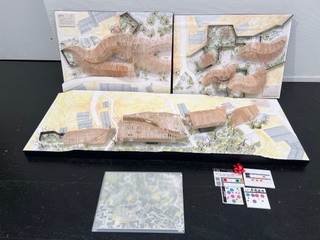
The projects went from single family homes to apartment buildings, from city centers to shopping malls, from airports to convention centers, from wooded parks to recreation areas in cities.

One of the most unusual designs was based on a pudgy human figure (upper left drawing). The artist used that to plan an area with swirling lines and curved spaces.

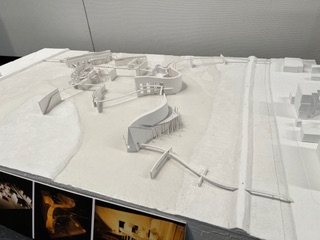

I was completely taken aback by the marvelous details of each piece. All so tiny. All so perfectly rendered. All feasts for the imagination, which someday may become real places.

In a way, the show was like my childhood doll house. Each display gave me the same sense of awe and wonder that I knew as a child. But these were far more detailed and varied.
The exhibit itself also filled me with tremendous hope. I feel very reassured that young people today can be magnificently imaginative and creative. I saw how they use their computers and artistic skills to make places that are livable, sustainable, unique, and indeed very beautiful.
Love,
Anne
The Heart of the Story
- At January 19, 2024
- By anneblog
- In Uncategorized
 0
0
Dear Family and Friends,
When I think of my recent trip to Kyushu, I keep hearing the words, “The Heart of the Story”. Indeed, Kyushu has been a very special place for well over a thousand years. And that energy can immediately be felt, albeit often subtly and almost unnoticed. Yet, it is there. And does indeed touch the very Heart of Being Itself.
Of course, some things there are just plain fun. Like tissue boxes made to look like Sakurajima volcano,


or lying under a warm volcanic sand pack.

The food was outstanding

and the landscapes stunning.

There was the small pottery village of Onda, where clay was prepared by long water-fed poles.

And Kengo Kuma’s Comico Art Museum in Yufuin was a breathtaking feast of architectural imagination.

And of course, there were the daily indulge of spas, and chatting with open and friendly locals.
But going deeper, there is an almost mystical energy the pervaded much of the land and its history.
As strange as it may seem, one of those places was the small town of Chiran in Kagoshima Prefecture. Nowadays it is famous for green tea. But it is also deeply connected to history, especially to war.
One section consisted of Samurai homes. Many Samurai were refined individuals who manifested the fine art of life, in all of its aspects. So, their homes included splendid borrowed-landscape gardens. That meant they incorporated the surrounding landscape as part of the garden design.
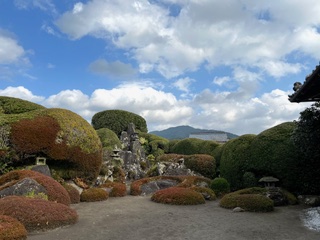
A deeply thought-provoking experience was the Chiran Peace Museum. The message of this memorial museum is extremely poignant today, especially considering the many wars the world is engaged in now. It is devoted to Kikkou (特攻), Kamikaze Pilots.
When I was a child, I was horrified by those “enemies” and how they waged war, (which tragically, has become all too commonplace today). But this museum presented the pilots deeply human side. The displays held photos of every young man who trained in Chiran. The exhibits carefully, almost reverently, explained who every one of them was. They gave precise details of their lives and training. Part of that included a final letter of appreciation written to someone they loved, most often their mother. And like Samurai before them, the wrote Haiku. These were preserved on national flags. The purpose of this profoundly moving Peace Museum was to provide a promise that human dignity is far greater and lasts longer than any war ever could.

Other significant places were the thousands of very old Shinto Shrines and Buddhist Temples all over Kyushu. They were surrounded by womb-like protective forests or perched on rocky cliffs jutting out to sea. Believers have made pilgrimages to those sites for over a thousand years, just as they do today.

One Shinto Shrine that affected me very profoundly was in Miyazaki Prefecture, in a small town called Takachiho. The shrine, Ama-No-Iwa-To, was next to a river and surrounded by hundreds of stone prayer towers, all made by pilgrims.

The altar was deep within a cave and its silence seemed boundless. Inside there was a circular mirror symbolizing the supreme Goddess of the Sun. She is Amaterasu Omikami, the Giver of Life. The hushed depth of the interior surely was meant to reflect our own Hearts, the most sacred part of ourselves.

Every evening, a sacred Kagura dance was held in another shrine. That performance had four parts. Three told the story of enticing Amaterasu Omikami out of Her cave in order to bring light into the world.

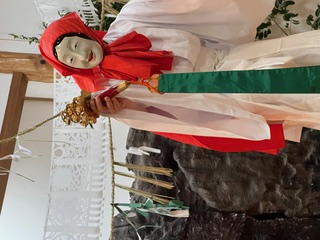

The fourth was people’s embrace of life when they were blessed with Amaterasu Omikami’s light and abundance.
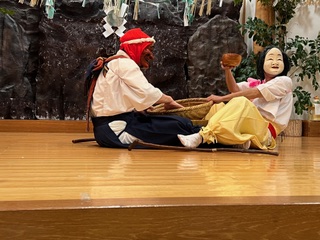
Further north, the Oida Peninsula had a ring of Shrines and Temples that have been part of spiritual pilgrimages for over 1,300 years. The structures, carvings, and statues there, although fewer, could rival many in Kyoto or Nara.

Tying all these experiences together was the beauty of the people. They radiated purity and openness. They were gentle, helpful, and kind. They seemed to look out on the world with trust and an expectancy for good. They were a lovely way to touch the Heart of Kyushu’s very old and ongoing beautiful story.
Love,
Anne
Cats and Prayers
- At January 03, 2024
- By anneblog
- In Uncategorized
 0
0
Dear Family and Friends,
My friend Izumi is one of the most creative persons I know. So, being with her is always full of the unexpected. That means times are interesting when we are together.
Actually, Izumi and I are so busy that we don’t meet all that often. But this past week we met twice. Once was for her stray cats and once was for a home Buddhist ceremony.
Izumi loves feline creatures. She feeds any strays that come begging. And once a much-too-small kitten was born in the entranceway of her home. Izumi felt so sorry for the sickly newborn that she brought it, the mother, and the healthy sister inside to take care of them.
She called an NGO specializing in stray cats. They gave her large cages because Izumi’s own cat was jealous and ready to fight the new comers.
Eventually, the baby got so sick that Izumi contacted a vet specializing in stray cats. In his clinic, he has one large room designed especially for his charges. There are places for them to climb and to hide. They are well fed and left to roam as they will.

Izumi’s three cats were terrified when they were put in this clinic. They hid in corners, ran wildly around the room and rolled back their ears in fright if a person came too close. They also refused to eat. So, the doctor told Izumi it was her duty to come play with the cats. And even then, if they did not get better in a month, he would return them to her.
So, one evening, Izumi and I went to the clinic. Only one cat, not Izumi’s, was lively. The others sat quietly and watched in a rather bored fashion.

Only Izumi’s were afraid. The teeny kitten was tucked behind her mother and totally refused to move. The mother was in super alert mode, while her other daughter hovered on the other side of the room.

Izumi and I sang and coaxed. Not much progress in two hours, but we tried. As we were leaving, the doctor said he would give the baby kitten back to Izumi at the end of the week if she still refused to leave her mother’s side.
On Saturday Izumi had arranged for a special ceremony to be held in her uncle’s house. He had died several years before, with no heirs. After many discussions, the family decided to demolish the house and sell the land. But before that work began, Izumi insisted they hold a “House Closing Ceremony”.

It took a few days to prepare, plus to get the priest to agree to come. But eventually, the dates were set. Izumi thought everything was going well. But that morning, the doctor called and said he wanted her to come immediately and get the smallest kitty.
“But I can’t!”“You have to!”
In this hierarchal culture, you do not say no to a doctor. Thankfully, another friend was helping. She agreed to go for the rejected little one while Izumi and I continued preparing for the ceremony.
Later, during the service, everything was going smoothly as the priest chanted and we prayed.

But Izumi had forgotten to turn off her phone. It suddenly began to ring. Izumi grabbed it and left the ceremony. The call was from the NGO woman. She had a key to Izumi’s home and found that the stray had gotten out of its box and was nowhere to be found. Izumi was frantic, but returned, pretending to be calm, and finished the ceremony with us.
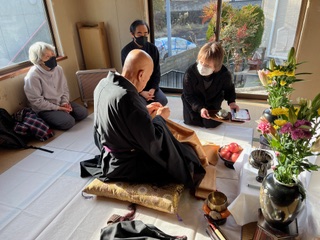
Izumi’s spouse, Yoshiki, will be out with his buddies one night after Christmas. Izumi did not want to be alone, so asked me to spend the night. She also asked me to cat sit while she and Yoshiki were away for the New Year. Being as fond of Izumi as I am, of course, I agreed to both requests.

I wonder what will occur when I am with Izumi’s cats on my own. Anything seems possible. But knowing her uncle’s blessed home is nearby makes it seem easier to accept whatever comes.
Love,
Anne
History, Culture, and Memories
- At January 03, 2024
- By anneblog
- In Uncategorized
 0
0
Dear Family and Friends,
Rumiko, my Japanese teacher, always has the most unusual ways of holding a class. Actually, our lessons have become day trips — when we only speak in Japanese, of course. She corrects my errors only if I ask a question. But usually she says being understood is more important than being perfect.
Rumiko knows I am interested in art. So, for this month’s lesson she really wanted me to meet her sister’s friend. She is not only an artist, but also the wife of a Buddhist priest. In addition, the husband is both a priest and an artist himself. They recently opened an art museum on their temple property. Rumiko wanted to see it herself, so arranged for our lesson to be there.
This artistic couple, Suzuki Hiromu and Naomi, live in Yamagata Prefecture. Their town, Higashine, is a rather long drive from Sendai. So, Rumiko asked her father do be our chauffeur. Of course, her sister Kumiko joined us.

Papa was much more elegant than I had expected. He appeared in a white suit and silver-gold shoes. His hair was newly dyed and permed. He wore white gloves when he drove. He was magnificent! And very laid back. And full of fun. He merits an entire letter of his own!
He was also an excellent driver, so the biggest hurdle of our trip was finding the temple. It was in an old neighborhood with unmarked streets (not even on the navigator). But we got finally there and were truly in for a treat.
The Suzukis met us and immediately ushered us into the museum. Actually, it used to be a kura, a large storage house used in times past. They moved this one to its present location and redesigned the interior completely. It was traditional on the outside and ultra-modern inside. Some walls were painted in soft colors but others were mirrors. High windows allowed for plenty of natural lighting.

The collection itself was very mixed. It went from very old calligraphy and Hina-Matsuri dolls

to recent pieces done by friends and themselves.


The Suzuki family has been priests for twenty generations. And many of them have been artists. Hiromu San’s great grandfather painted a stunning folding screen of the four seasons.

While Hiromu San himself did rather subdued pieces reminiscent of the Spanish artists he so admired and copied when he and Naomi San spent eighteen months in Europe for their honeymoon. They studied art at the Prado for half a year and traveled extensively the rest of that time.

The museum also had antique items. There was a collection of fine glass bottles,

several breathtaking dowry chests,

a rather large safe with three levels of doors to unlock before finally getting access to its contents.

There were Persian carpets and an old wooden staircase with drawers under each step.
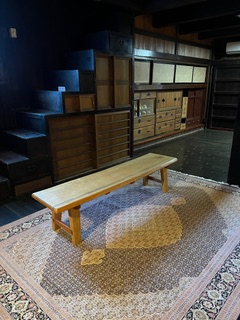
And there was much more.
After admiring everything in the kura museum, we were ushered into the main house. It was a vast labyrinth of hallways and rooms, very easy to get lost in.
There were ikebana arrangements in every nook and on every tabletop. And the entire place was bulging with generations worth of books, antiques, and art pieces.

The work involved to keep the place so pristine and orderly was staggering.
Parts of this complex web of rooms and corridors were also very lived in. Strings of persimmons were hanging down a staircase, for example. Two bicycles were parked in one of the storerooms, along with two Buddha heads.

Naomi San had an art studio, where she painted daily. Hiromu San’s office was tucked into a small corner between two hallways and yet another staircase. The kitchen-dining area was small and warm. The rest of the house was freezing.
There were more than rooms, all of them filled with truly breathtaking pieces of art, antiques, and crafts handed down over centuries. The home itself was almost more a museum than the converted kura was.
The temple was another impressively adorned area, with items extending back well over 500 years. In fact, the entire complex of museum, temple, and home was a treasure trove of history, culture, and memories.
Late in the afternoon, we paused for coffee. But Papa announced he was going to a local spa for a good soak while we indulged in sweets and caffeine.
We expected him back on about ninety minutes, but that extended to two hours, even longer. At last he called to say he was completely lost. It was dark, the car navigator was useless, all the narrow streets looked the same. He asked local people for help, but that did not work. So, he finally called and all of us together (excluding me) gave him directions by phone.
He eventually arrived. We all said our farewells, bowed, and drove off into the night.
Naomi San wants to come to Sendai once a month for “English lessons”. But I get the feeling we will go to museums, take walks in parks, and simply enjoy being together and chatting. No matter what, I am looking forward to whatever unfolds.
Love,
Anne
Celebrating Shared Memories
- At January 03, 2024
- By anneblog
- In Uncategorized
 0
0
Dear Family and Friends,
Kurumada Sensei turns 85 today.

She was the Head of the English Department at Shokei College when Izumi, Yoko, and I worked there. Actually, Yoko was my student before she joined Izumi as a secretary of the department. Together we were a real team.

Izumi often says those were, without a doubt, the best years of her entire life.

With Kurumada Sensei in charge, things were well run, but without an authoritarian bent. So, as long as the work got done, she left Izumi and Yoko alone. That meant there was a lot of time for laughter and just having fun.
I was pretty new to Japan then. So, my language skills and know-how in this culture were minimal. But Izumi and Yoko took good care of me, so we became great friends, and still are.
I left Shokei almost twenty years ago. The English Department closed down soon after. Izumi got sick and left last year. Yoko is still there, but in the main office. So, those delightful years of the three of us, guided by Kurumada Sensei, are long past. In fact, we seldom see each other anymore.
But a few months ago, something kept nudging me to contact Kurumada Sensei again. I have learned to heed that call. So, I visited her in her home. While there, I learned she would turn 85 this year. I mentioned that to Izumi and we thought a party for her would be fun. Yoko, of course, would be part of the celebration. And leave it to Izumi, she remembered a restaurant that another former Shokei student, then English Department secretary had with her husband.

The restaurant, Cloud 9, is small and simple. But the food is out of this world. Course after course of it. The tastes and colors blended subtly and perfectly. We were in awe with each presentation and bite. We joked that we must be on Cloud 10 with such a feast.

Usually Cloud 9 is open only in the evening, but for us, they opened for lunch. Even though the husband-chef was busy preparing our meal and those of the evening, he came out several times to chat with us.
He learned how to cook by going from place to place, pretty much all over Japan. He learned well. In addition to that, he loves experimenting, so he had very unique dishes. Some, like octopus and Miyagi beef, that took three days to prepare.
He (and his wife Yumiko) stirred tofu until it was like cream. They added a secret ingredient and poured it over strawberries. They served small pieces of fish that were to be eaten with a finely sliced, dried citrus fruit. And they made a dipping sauce with mild vinegar and dried plums.
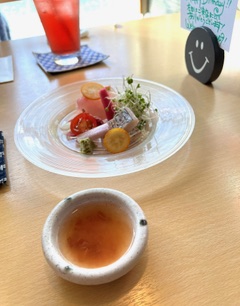
Meals here often end with miso soup and rice. Even that was spectacular. The rice was bulging with vegetables and the soup included delicious mushrooms and fine seaweed. Kurumada Sensei was so thrilled by the day’s event, that she insisted on serving the rice to everyone.
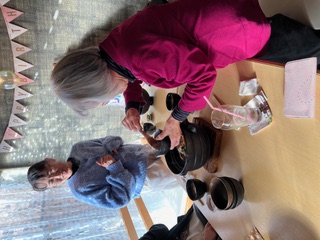
We thought we were finished. But no. Out came the desserts. One Western, one Japanese. Again, tastes were unique and the chef’s secret.

Kurumada Sensei looked exhausted by the time we got her back home. But all of us felt very satisfied with the celebration. We also felt very happy to have added another delightful memory to the storehouse of those we had already created long ago.

Next year Yoko turns 50 and I become 75. I wonder if we will get together again. And could it possibly be as delicious and satisfying as Kurumada Sensei’s wonderful 85th?
Love,
Anne
500 Years
- At November 17, 2023
- By anneblog
- In Uncategorized
 0
0
Dear Family and Friends,
My friend Izumi is imaginative and very creative. Because of that, interesting things seem to come to her naturally. And because of who she is, she most often says yes to the many opportunities coming her way. Very kindly, she sometimes invites me to join her. Recently, she asked me to a very special Buddhist ceremony.
The paternal side Izumi’s family follows the Soto Sect of Buddhism. Although her father is buried near his country home, the family is now a member of a temple in Sendai. It is called Genkoan (玄光庵).
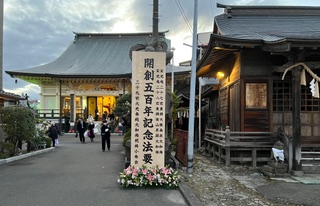
This year is very important for that temple. It turned 500 years old. That privilege must be honored. In addition, the head priest had recently died. So, his memorial service was part of the day’s events.

Priests and parishioners came from far and wide for this rare occasion. And Izumi, very thoughtfully, asked me to go with her.
Izumi expected us to be in the main hall. However, since so many attended, it was open only to priests and family members. The rest of us were in a separate building, where the service was broadcast live on large screens.
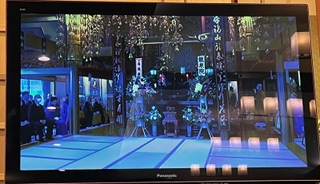
When we arrived, Izumi asked where I would like to sit. “Up front, of course. That way we can see better,” I replied. Later, Izumi whispered to me that as a Japanese she felt embarrassed to be in such a prominent place. But then a gentleman and his wife sat next to us, so she felt less conspicuous.
I was fascinated that most of the priests wore a robe of olive yellow over the usual black attire. I had never seen that before. So, I wondered if it were for this special day. But Izumi told me that it showed their rank of priesthood.

However, the current head priest of the temple wore different colors according to which part of the ceremony he was performing.
The ceremony had four parts. The first was the longest. The priests walked in a circle around the main hall as they chanted and tapped bowl chimes. They were creating sacred energy that would bless the temple and honor its 500-year-old existence. It also was setting the stage for its future.
The second part was very interesting. In a booming voice, the current priest called out the names of all the main priests from the temple’s inception until his recently deceased father. In so doing, he was thanking them and also asking for their protection and guidance for the next half century and beyond. He wore bright orange during that part of the service.
We had a short break and then the third part began. It was to be a “debate”, as Izumi called it. But actually, the visiting priests asked questions to the temple’s main priest, who was wearing a red orange robe under a black outer garment. Again, that was something I had never seen.
Izumi and I were expecting complex Buddhist doctrines to be discussed. Instead, the questioners went up one by one. And with their strong, deep priestly voices asked such things as: “What sort of tempura do you prefer?” And “Do you ever sing in karaoke? What songs are you good at singing?”
After booming forth his question and getting an amused reply, the priest would turn and powerfully chant something to the effect of “I received a helpful answer,” as he walked back to his place. Then the next one went forward with just as much authority to ask his question.
For the final part of the ceremony, we were given a choice. We could stay where we were or go to the main temple. Of course, Izumi and I chose to change places. That way we could experience the event live.
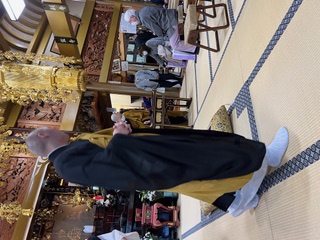
For this a priest had come all the way from Hyogo Prefecture. It had taken him five hours to get to Sendai, and he would return that evening. Curiously, this man had studied Rakugo. That is the art of comic storytelling. He told us all about his history, in his trained Rakugo voice.
It seems his family had been doctors for many generations. But his grandfather became a priest. His son and now his grandson followed him. But this man ventured far afield before settling into priesthood. That is, he was a Rakugo performer.
He learned his skill well. He told us stories with dramatic changes in voice and gesture. Most were hilarious tales of naughty children being scolded. But he would interweave Buddhist teachings in among those daily life realities. Everyone loved it. One old woman laughed so loudly, the priest stopped and asked if she were having a good time, of course in Rakugo style. And at the end, he shook her hand and bowed his thanks to her.
This final part of the day was a sort of initiation ceremony for the new main priest. What a warm welcome and encouragement for everyone connected to the temple.
Izumi and I left feeling very relaxed and blessed. It was a long, but very good day. We are already planning our next meeting. But for now, what we just experienced was very rewarding indeed.
Love,
Anne
Vive la Difference!
- At November 09, 2023
- By anneblog
- In Uncategorized
 0
0
Dear Family and Friends,
Wakako San is a friend who works in a skin care company. Her responsibilities include caring for her clients’ skin, of course, but also their general health. The company runs frequent seminars and has a lounge where members can enjoy spending time together.
Since it is such a relaxing place, very often people tend to open up and talk about their problems. Wakako San found that she was unable to help her clients as she would like. She also had problems of her own: an alcoholic father. Wakako San lived with her parents, so she and her mother experienced his abuse firsthand.
With these issues, Wakako San enrolled in an online Master’s program in psychology from an American university. Much of her studies and papers were in English. So, I often helped her. That allowed me to follow the course and also for Wakako San and me to become better friends.
One time when I stopped by the lounge, Wakako San seemed rather upset. With her head bowed low, she whispered to me that her mother had embarrassed her tremendously. Her father had been hospitalized for several months (not uncommon in Japan) and was scheduled to be discharged.
In the doctor’s office, Wakako San’s mother pleaded, “Please don’t send him home. He gets drunk every night and becomes very violent. I can’t stand it any longer. Please find another place for him to go!”
Wakako San then said, “I was totally astonished that my mother could be so selfish! And in front of the doctor, no less. Everyone will hear about this. It is shocking. I feel very ashamed. How can I hold my head up in the town where we live?”

I let Wakako San finish telling me her story. Then very calmly I said, “You know, Wakako San, as an American, I see things a bit differently. From my perspective, you should be very proud. Your mother has shown that she has gained enough self-respect that she does not have to put up with abuse anymore, even from her husband. She had enough courage to show her true feelings, no matter what the doctor or the neighbors would think. I see this as a huge psychological step forward. If she were my mother, I would be immensely proud of her.”

As I was talking, Wakako Sans slowly turned her head in my direction. The expression on her face was one of disbelief. I had felt the same when I was listening to her, but tried not to show it.
I also do not know what Wakako San was thinking. Maybe she was horrified that even after I had lived in Japan so long, my attitudes remained so “selfish” (from a Japanese perspective). Or maybe it started to dawn on her that what she had studied as a student of psychology could actually be applied in her own life.
I do not know what arranges were made for her father after he was discharged from the hospital. I do know he died a few months later. I also know her mother, despite being crippled with arthritis, goes to a senior center every day. She enjoys laughing and joking with the folks there, and says she has never been happier in her life.
I do not see Wakako San very much. We are both busy. But I hope our exchange helped her as much as it did me. It was such a beautiful reminder that even when cultures and ways of thinking are entirely different, there is still room for wonder, for appreciation, and of course, deep respect.
Love,
Anne
Last Hike of the Year
- At November 04, 2023
- By anneblog
- In Uncategorized
 0
0
Dear Family and Friends,
Today was the last hike of the year. Originally, we were planning to go to a faraway place, promising a rough climb. But one of the members pointed out that we are all older now. He felt such an effort in one day would be a bit much. So, our leader, Ajiki San, settled on a mountain within Sendai City limits, but very much in the countryside. In fact, we passed many well-tended farms to get there.
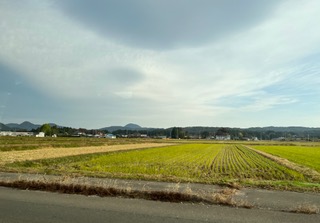
It was a long weekend and the leaves would surely be stunning. So, we were not alone. The parking lot was almost full when we arrived early in the morning. But even so, once we were in the forest, we could easily immerse ourselves, as if alone, in Nature’s autumnal gifts.


Ajiki San, as usual, shared much information with whomever of us was nearby to listen. He explained about a certain plant that when dried could be made into a tea that soothed the stomach.
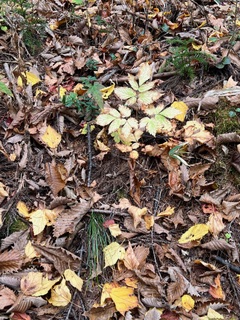
And later about a large leaf that was also useful. In the past, people wrapped miso in it to give a lovely taste and aroma to the paste.
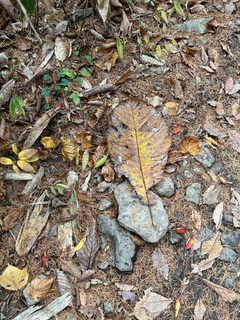
He talked about camping in the woods. Once he felt the spirits of ninja creeping past his tent, even as he was soothed by the gentle flowing sound of a nearby stream.

“The forest is alive,” he said. “Alive with the distant past, what is now and to come. There is wisdom there. We have to learn and respect its stories.”
He also told us about Edo and Meiji Era customs. I asked him if he read a lot of books to get knowledge about the past. “Sometimes,” he replied. “But I prefer talking to old timers. They know things firsthand, so I feel they are more reliable. Plus, they recount customs that are so ordinary they never make it into books.”
A trip is not complete without at least one mishap. This time, fortunately, it was easily resolved. When we reached the peak of where we wanted to go, another hiker came running up to us. “Have any of you lost a phone and wallet?” We all started pawing through out belongings. Suddenly one of us said, “It’s me! I can’t find either!!”
“Not to worry. They will be waiting for you at the Information Counter down at the parking lot.”
And sure enough, that is where they were. All money and credit cards intact, phone smiling happily.
Somehow that reminded me of an incident I had a few days ago. My bike needed air in its tires. I walked it to the supermarket, where I could borrow a pump. The thing was well used and in rather bad shape. But even so, I endeavored to hold the ill-fitting nozzle on the tire with one hand, while trying to pump with the other. It was rather awkward, to say the least.
Suddenly I heard someone say, “Can I help you?” That was music to my ears.
The kind gentleman and I worked together to somehow get my bike tires filled with air. As I thanked him profusely, he bowed and said, in English, “My pleasure,” and then quickly departed.
It is so encouraging, and necessary — maybe especially today — to experience beauty in the world. The Beauty of Nature and the Beauty of the Human Heart.
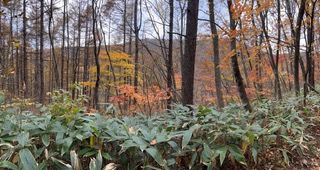
Love,
Anne
A Day of Delights with Three Little Ladies
- At October 31, 2023
- By anneblog
- In Uncategorized
 0
0
Dear Family and Friends,
What is it like taking a day trip with three older Japanese women? Yesterday I found out. My friend Reiko San invited me to join her and her friends on a trip to Fukushima Prefecture. All three of them were in their late 70s, were rather short, and loved to talk. I towered over them, very much the “gaijin”, but not feeling out of place.
On the train, the three of them chattered like young school girls. They seemed to compete over who could tell the silliest stories. Their voices were loud and full of giggles. Normally, trains are very quiet. But no one seemed to mind four older women enjoying time together, away from their many serious responsibilities.

I mostly sat and listened, amused that they talked and laughed non-stop for well over two hours.
I also greatly appreciated the scenery.

The farms and mountains were stunning. Many places were still bringing in the rice harvest.

Others where bulging with apples more than ready for picking. Persimmon trees also dotted the landscape. Needless to say, Fukushima fruit is famous.
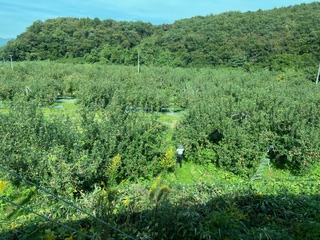
When Reiko San originally invited me, she said we would go to the Fukushima Prefectural Art Museum and then to a nearby local onsen. I was thrilled. I appreciate seeing art whenever I can. And a nice hot soak is always a welcomed treat.
But as soon as we were seated on one of the several trains we took, Reiko San announced that it would be one or the other. “No time for both. So, which is it?”
I was surprised and rather disappointed. So, I started asking questions. Maybe we could find a way to have both: art and a bath. The other two simply sat quietly, politely smiling. Not being used to anyone questioning decisions, Reiko San thought my questions were demands. They were not. It took a few dramatic exchanges before we agreed on a brief look at the museum grounds, maybe lunch there, and then on to the spa.
The museum visit was indeed brief. The lunch there nice, but more than we needed. However, going there was a good incentive to return later, probably on my own.

Then we headed to the spa town. We followed what our generation most often does; we did not rely on Google for information. Rather, we talked to locals. They were more than delighted to help us, and then to chat. They even went out of their way to make sure we were headed in the right direction.
The onsen village was lovely. Old buildings had been converted to hotels or shops.
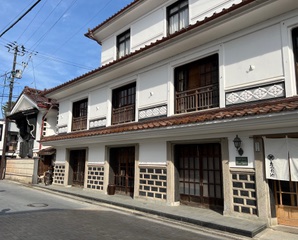
There was a restored water tower.

And the former village head’s home had become a small park with a lone persimmon tree and free foot baths. Many locals came and spent a long, quiet time soaking their feet and reading, doing computer work, or sleeping.
We decided on a local bath. It was in a very old building with a beautiful ceiling.

The water was hot and delightfully soothing. But even there, we did not stay long. I have found that Japanese trips with friends are often a quick, superficial encounter with place, contrasted with unending, unrelated chatter among participants.
Another part of the ritual of a day trip is that everyone brings something for the others. I did not know that, so had nothing. But I surely will the next time.
Another ritual occurs on the way home. No matter how full you might be from lunch, you have a snack. I was simply not hungry, but the others ate and continued chatting and giggling as they rubbed their stomachs and said over and over again how full they were.
After that, the door was open to tell personal stories. One woman told about her grandson who became uncontrollable after his parents’ divorce when he and his father returned to live with her. He is a constant problem. Another has a mentally challenged son, now an adult, who lives with her. He has simple jobs, but his mom often fills in for him.
The other lady’s job was fascinating. She works with Japanese nationals who were born in China during WW II and forced to stay there when the war ended. Until recently, they lived their entire lives in China, often marrying locals. But in their 70s, they were repatriated. They came here not knowing the language or the culture, and some without family. And now they are in nursing homes. I asked why they returned to Japan. “Because they always wanted to,” was the reply. Such deep inner identity with place is something alien to my American pioneering spirit.
After dipping into their personal worlds, they had permission to fall asleep, which all of them did.
I got off the train before the others. I left them all snoring. I knew they would be all right since they were heading to the last stop. The conductor would get them off the train if they were still snoozing.
Unless it is hiking, I do not usually go on day trips with others. But I found those three ladies fun to be with.
They obviously enjoyed our day, too. We promised to meet again before the end of the year. If not for another day trip, surely for a Year End Party. We want to celebrate the happy times we shared in 2023. And we hope for good health and free time to do more together, and maybe with others, in the year(s) to come.
Love,
Anne
A Remarkable Man
- At October 09, 2023
- By anneblog
- In Uncategorized
 0
0
Dear Family and Friends,
Yesterday I went on another adventurous hike. I had thought I would write about it specifically. But this morning I realized the leader of the group, Ajiki San, would be equally as interesting. He is an older man, in his mid-70s, and is always upbeat, but not silly or superficial.
There were only seven of us going yesterday. So, we went in two cars. Private transportation would save us time since we were going to Yamagata, the neighboring prefecture. The group consisted of four men and three women. I was fortunate to go in Ajiki San’s car, and even more so to sit next to him. That way I could hear his stories. He loves to talk and has a wealth of information.
On the trip going we discussed mostly about what to expect on the hike. Ajiki San also answered my many questions about the farms and villages we were passing. I am always eager to learn more about this Tohoku region, and he is always delighted to share his knowledge.

The hike began with us going part way up in a “gondola”. After we had walked through a small forest to reach the real climb, one woman said her knees hurt and would not go any further.
“I’ll just stay here and wait,” she said. It was cold and windy with no place for her to shelter. So, one woman of the group, Otowa San, who had really been looking forward to the climb, opted to stay with her. Later, they would head back to the parking area where there were restaurants and shops.
“Anne, what will you do?” Otowa San asked. “I’m going with the guys,” I replied, maybe a bit selfishly. Years ago, when I first got to Japan and did not know about the rigors of hiking, I had done the same thing: opted out. But when the same woman, Otowa San, offered to stay with me, I flatly refused. Instead I spent the time drawing, luckily having taken along a sketch pad.
When that group returned, and we were heading to the cars, AJiki San said to me, “Why didn’t you give one of your drawings to Otowa San? She offered to stay with you.” I was surprised. Why should I do something like that, I wondered. “That is how we do things here in Tokoku”, he continued. I was still firmly locked in an individualistic mindset. Plus, I did not feel my work was good enough to even show anyone, so I did not give one to her.
Yesterday after waving good-bye to Otowa San and Suzuki San, the rest of us began to focus on getting up the mountain. As we ascended, the views became more gorgeous with a wide sweep of mountains and leaves just hinting change.

Zaoh Mountain is famous for “Snow Monsters” in winter. They are the hundreds of insect-killed trees that become covered in snow. The fierce winds blow the powder into truly monstrous shapes. For us, though, they were only dark frames waiting to be beaten by gales and clothed in their winter garments.
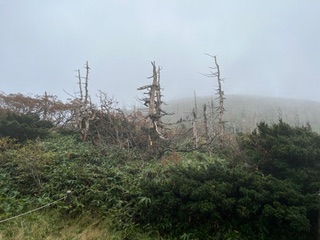
Ajiki San was an excellent leader, as usual. One man was older and more frail than the rest of us, so needed more attention. Ajiki San went beside him, even as he told us about plants and the many changes he has witnessed over time. He has been hiking Tohoku mountains for over 50 years and knows them well.

The other members of the group are all white-collar professionals. A few are retired university professors, one still works for the city government. Ajiki San, on the other hand, is a builder and carpenter, in addition to a driver for a day service center for oldsters. In a hierarchical society like Japan, it says a lot that everyone in the hiking group looks up to Ajiki San with great respect. And Ajiki San remains forever humble, towards all others and towards the vast powers of Nature.
At almost the top of the mountain, we had a brief lunch and then headed off right away, no time to rest after eating. But ill luck seemed to follow us. About half way down, the left leg of the oldest, rather frail, man gave way. Ajiki San was right there, easing him into a sitting position. We all waited until the intense cramping seemed to have ended.
But no sooner had we taken a few steps than the man collapsed again. This time his brain went blank. Ajiki San, as always, was very calm and attentive, knowing just what to do. Another man raced down the mountain to get his car and another called the ladies below to let them know the story.
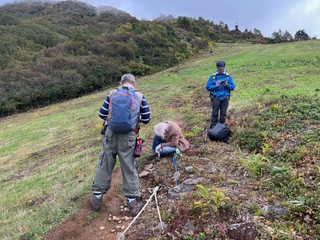
Eventually, the man came to and we all were brave enough to continue the very precarious trek to where our friend would meet us. I could not get my mind off of the situation at hand. But to my amazement, all three of the men were telling unrelated stories and laughing loudly.

Later, I asked Ajiki San about that. “Life is full of problems. So, we do what we can to solve them and then focus on a larger picture. It is important to always balance things. That is how life works,” he replied.
Later, on the drive home, after all we had been through, Ajiki felt he could trust Suzuki San and me enough to talk about himself. He had grown up in this rural area. It was right after WWII, so people were poor. But they were determined to build their lives back up from scratch. Ajiki San got through high school and became a carpenter and builder, the work he still does today.
When he was 55, he was hospitalized for several months. “That gave me lots of time to think,” he said. “I realized I wanted to do more with my life. So, as soon as I got out, I enrolled in Tohoku Open University. I love it. I learn so much there. And it is affordable. That is where I met the people in this hiking group. I could never be in contact with people like that if I had not stepped out of what I had done all my life.”
(As an aside, I should add that Ajiki San’s writing is truly refined. His script looks like works of art. I feel as if I write with my foot when I compare what he produces to my scrawl.)
He told us about working as a driver for a day service center for oldsters. “I am there regularly and when they need me. Tomorrow is a national holiday, so I will be there. Other drivers have families. I would not want them to be away from their kids.”
Then he added, “You know who I truly admire doing this unseen job, being there whenever people need me? Garbage collectors. They are the base of society, are needed and used every day. What would our world be like without them?
“Now my life is well balanced. I work twice a day as a driver. I free-lance fixing houses. I do that when I want. I hike whenever I can. I have a hearing aid, so I am not cut off from life. My wife fusses that she does not like the Enka and Mood Music I play. So, I bought ear phones and we both are happy.
“Of course, life gives me problems. But I am a Tohoku man, so I shrug my shoulders and say, ‘Don’t mind’. I want harmony in situations, balance. That is what life is about. And I have, to at least try, to make it happen.”

A man I deeply admire, Ajiki San. Thank you. And I am looking forward to what unexpected surprises our next hike has to bring.
Love,
Anne



